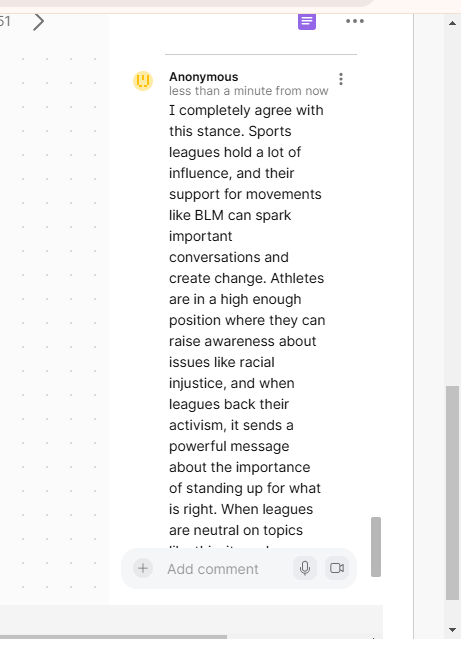3
Section One: The Fundamentals
A) Keywords
Exercise 1:
Briefly (in 100 words or less) define one of the keywords in the padlet (including one that you. may have added yourself).
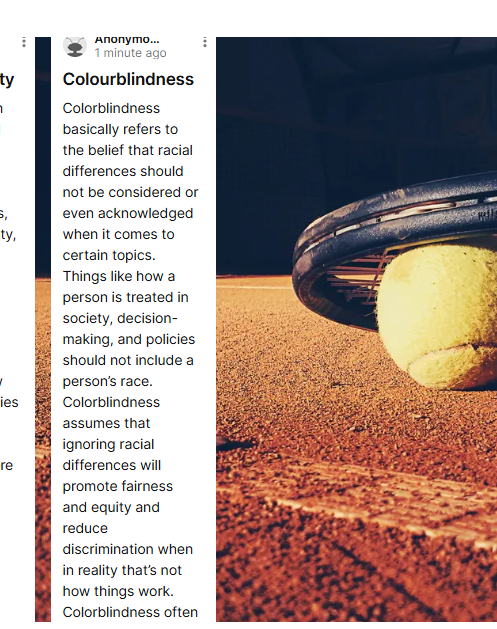
Colorblindness basically refers to the belief that racial differences should not be considered or even acknowledged when it comes to certain topics. Things like how a person is treated in society, decision-making, and policies should not include a person’s race. Colorblindness assumes that ignoring racial differences will promote fairness and equity and reduce discrimination when in reality that’s not how things work. Colorblindness often overlooks racial discrimination and the unique experiences of different racial groups. An example of colorblindness would be schools overlooking the fact that POC kids have different experiences than white kids in their classes. Schools often refuse to collect data relating to race, thinking that they are promoting fairness when in reality they are overlooking systemic issues. Issues like how some groups have a better advantage and resources than other groups. Or how some disciplinary actions target a specific group of kids over others. By actually seeing colour in these issues, educational inequalities may be addressed. |
B) Representing Race

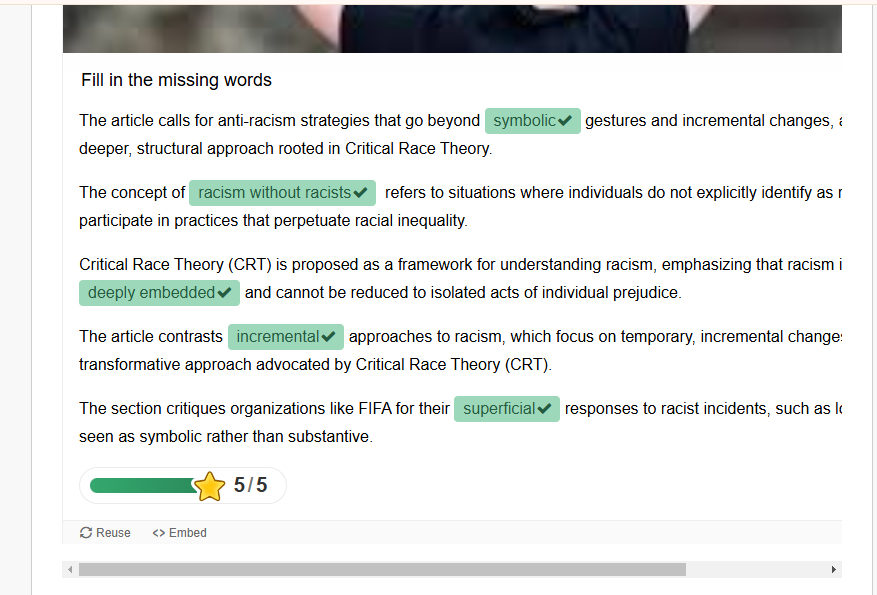
Exercise 2: Notebook Prompt
In about 50-70 words, consider Joel Bervell’s question: why do we feel the need to extrapolate the athleticism of one Black athlete to all Black people when we do not do the same for white athletes?
Try to think of examples when this happens, making sure to reflect on your own positionality.
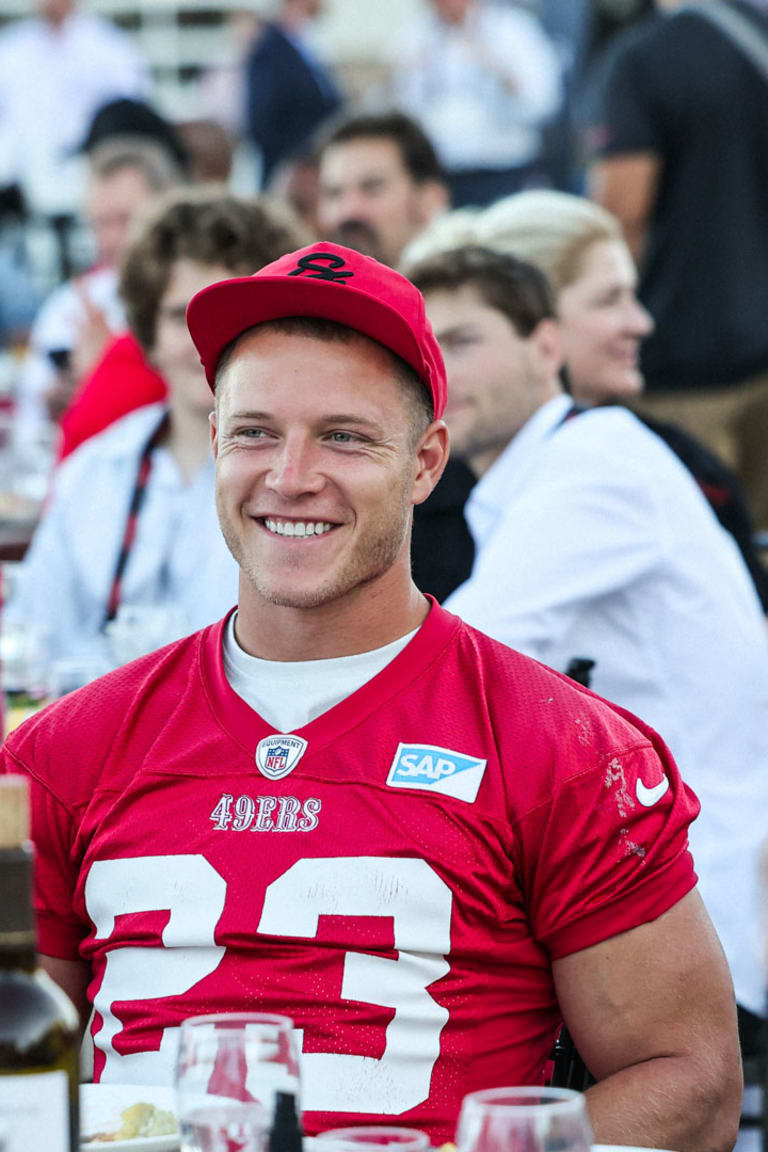
One very obvious example of racial generalization would be that many fans and commentators assume Black athletes are successful because they are naturally gifted, rather than working hard, having skill, and using strategy. Traits like a Black athlete’s “speed” or “genetic advantages” are usually praised and focused on by people, while white athletes are seen as more “hard-working” and “smarter” when playing sports. A lot of the time, many people who don’t face these types of stereotypes won’t notice them in the media and how frequently they appear. Many Black athletes have probably been reduced to their physical abilities and that’s it, having their skill and hard work overlooked. A real-life example would be how commentators at football games will praise Black athletes for their “natural” speed and other “natural” physical abilities while ignoring any real skill they put into their play. The commentator’s language often indicates that Black athletes’ abilities are common amongst them and even “expected” of Black athletes. A specific example would be Christian McCaffrey, who was a white running back in the NFL. When McCaffery would do well, the commentators would praise his “work ethic,” while any Black football player who was in his position was praised for their “speed” and “natural abilities.”
|
C) Gender, Race & Sport
Exercise 3: Notebook Prompt
What are some strategies for resistance that Rajack and Joseph identify in their article as a means of pushing back against and resisting misogynoir?
|
Some strategies for resistance that Rajack and Joseph identify are:
“At a free event held on September 22nd at Futakotamagawa in Setagaya, Tokyo, the comedy duo “A Masso” (Ai Murakami and Aiko Kanou) ridiculed Osaka’s skin color…Osaka wasted no time responding through Twitter, dropping the name of one of her sponsors in the process: “Too sunburned’ lol that’s wild. Little did they know, with Shiseido anessa perfect uv sunscreen I never get sunburned [three smiling rosy cheeked emojis]” (September 29, 2019).” (Rajack & Joseph, 2021) 2. Representing, embracing, and showcasing her Haitian and Japanese side through social media. By celebrating both of her multicultural identities, she is challenging any attempts to erase her identity. “When she emphasizes Haitian and “Blasian” (Black-Asian) ideas through videos, images, words, and links on her social media sites, Osaka’s self-representation is an act of resistance to the mainstream media” (Rajack & Joseph, 2021) 3. Osaka also advocates for issues like racial injustice and police brutality. This brings attention to systemic inequalities.
Razack, S., & Joseph, J. (2021). Misogynoir in women’s sport media: race, nation, and diaspora in the representation of Naomi Osaka. Media, Culture & Society, 43(2), 291–308. https://doi.org/10.1177/0163443720960919 |
Section Two: Making Connections
A) Athlete Activism
Exercise 3: Padlet Prompt
Do athletes have a responsibility to use their platform for social change? Why or why not? Please remember to record your response in both the padlet below and in your Notebook.
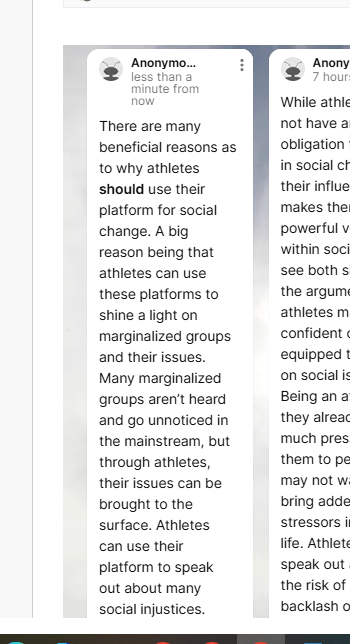
There are many beneficial reasons as to why athletes should use their platform for social change. A big reason being that athletes can use these platforms to shine a light on marginalized groups and their issues. Many marginalized groups aren’t heard and go unnoticed in the mainstream, but through athletes, their issues can be brought to the surface. Athletes can use their platform to speak out about many social injustices. They can also inspire many young people to create change. Athletes are seen as role models and can influence many people, so using this power to bring awareness to certain crowds can create big change. This can also inspire young fans to be socially aware and to take action where it is needed. Lastly, athletes can shape the public’s opinion on many things and can encourage their fans to think critically about social issues.
B) Athlete Activism & Feminism
Exercise 4: Complete the activities
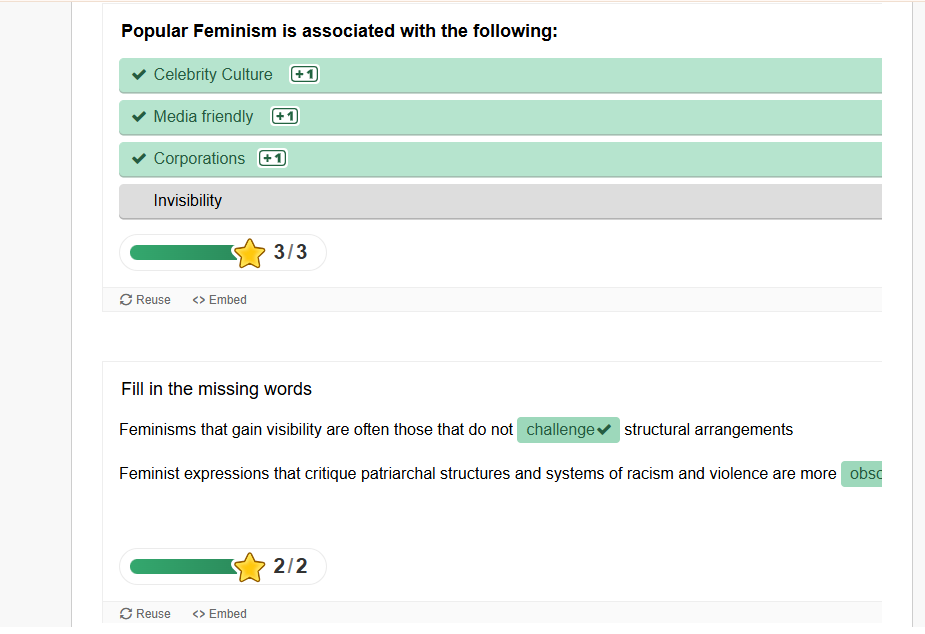

Exercise 5: Notebook Prompt
What do the authors of the article call for as a way of challenging how mainstream sports journalism privileges neoliberal feminist concerns? (100 words max.)
|
Cooky and Antunovic call for a more broad and inclusive approach to feminist activism in sports media that challenges the neoliberal feminist framework. Neoliberalism often focuses on individual success rather than class issues and structural inequalities. The authors of the article suggest that we move the narrative from individual to collective struggle. This means that we should focus on how collective efforts can actually bring real change in sports, like gender equality. The authors also mention how intersectionality plays a big role in feminist activism. Sports media more often than not ignore things such as race, class, and sexuality; by reflecting these issues within the media, these factors can influence feminist activism in a much more inclusive way. Also, the authors want us to look at how race, gender, and class are more deeply rooted in the system and how we should be focusing on that rather than individual athlete struggles.
|
C) Corporate social justice
Exercise 6: Padlet Poll
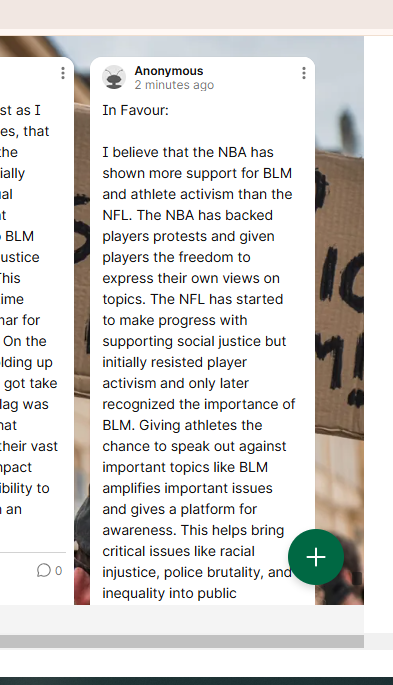
I believe that the NBA has shown more support for BLM and athlete activism than the NFL. The NBA has backed players protests and given players the freedom to express their own views on topics. The NFL has started to make progress with supporting social justice but initially resisted player activism and only later recognized the importance of BLM. Giving athletes the chance to speak out against important topics like BLM amplifies important issues and gives a platform for awareness. This helps bring critical issues like racial injustice, police brutality, and inequality into public conversations. Also having athletes speak out about these issues empowers others, especially young fans, to stand up for what they believe in and to fight against systemic racism. Like one of my peers said, staying neutral on important topics like BLM is not really staying neutral.
I completely agree with this stance, Sports leagues hold a lot of influence, and their support for movements like BLM can spark important conversations and create change. Athletes are in a high enough position where they can raise awareness about issues like racial injustice, and when leagues back their activism, it sends a powerful message about the importance of standing up for what is right. When leagues are neutral on topics like this it can have more harmful outcomes then beneficial ones. If leagues want to make real progress they need to go above and beyond and commit to meaningful action that addresses systemic inequalities.
|
Section Three: Taking a shot
Module Assignment (submit as part of notebook and separately through Blackboard mini assignment #1 portal)
Analyze the representation of a racialized athlete activist in a show (television or film or novel) of your choosing and answer the following questions:
- What strategies do athletes employ to speak out? What is the commentary on athletes using their voices in these shows?
- How do race and/or gender or other *identities inform this representation? How do these representations shape how we understand the sports themselves? Responses should be approximately 300 words, use specific examples from the selected cultural text (some examples below), and engage with one of the readings from this week (at least twice).
Worth: 5% (in addition to the module grade of 5% based on padlet engagement and quality of reflection prompts)
Submit with Notebook for Module Three by February 20.
When I was in high school, I remember hearing a lot of talk about a man named Colin Kaepernick and how he knelt during the U.S. national anthem instead of standing. I didn’t really understand or care at the time, not knowing how impactful him kneeling was going to be. Years later, the TV series Colin in Black & White (2021) tells his story and how he became an activist. The show talks a lot about the struggles he faced as a Black athlete, leading to his famous decision to kneel during the national anthem to protest police brutality. His main way of speaking out was through a peaceful form of protest, which was kneeling to send a message about racial injustice. However, the show also reveals the consequences of his actions, as he was blacklisted from the NFL. This reflects Ramsey Khabbaz’s argument in Sports and Social Justice that some leagues, like the NFL, have resisted activism. Kaepernick’s story shows how speaking out in sports is not always accepted, even when the message is about fairness and justice. The series challenges the idea that athletes should “stick to sports” and instead argues that they have the right to use their voices. This connects to how the NBA has handled activism differently. As Khabbaz explains, the NBA has supported players like LeBron James in speaking out for BLM, showing a more open attitude than the NFL. The show also addresses how race affects Kaepernick’s experience in sports. He faces racism on and off the field; he not only is treated differently than white teammates but is also constantly stereotyped. His identity as a Black man is a key part of how people see him, reinforcing Khabbaz’s point that sports and society go hand in hand; sports reflect the problems of society. The show makes it clear that sports are not just for entertainment; they are also places where race and activism collide. By telling Kaepernick’s story, Colin in Black & White helped me understand the challenges Black athletes face and how sports can be a platform for social change.


